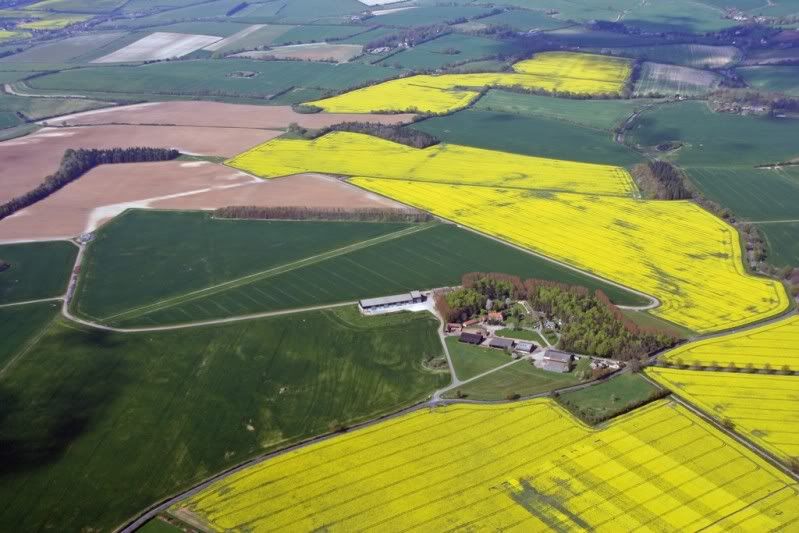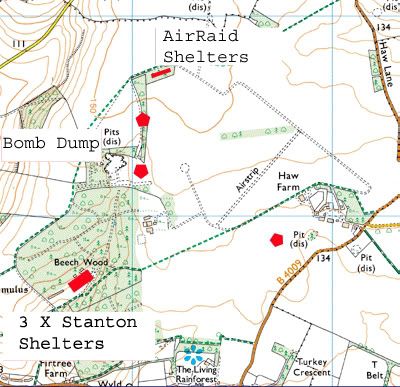
This is the east/west runway and just a line of trees show where it once was.
Its a very unusual design as all the runways cross at the same point, which I thought was not allowed due to if bombed at the apex all runways would be out of action?

The main runway although now grassed over is still used by the farmers plane. The main runway was lengthened from 1400yds to 2600yds in 1942.

Shot dated from 1955.

View dated from 2007


The airfield in West Berkshire was opened in the summer of 1940 and began it's role as a dispersal airfield and the home of 15 OTU (Operational Training Unit). Sorties flown were mainly day and night training flights in Wellington Bombers although the primary function of the airfield was to ferry the Wellingtons to Egypt, via Gibraltar and Malta.
On the 16th of September 1940 three bombs were dropped upon the airfield's metalled runways, apparently causing very minimal damage.
On the 4th March 1941 a wellington was attacked by a rogue German fighter as it approached to land.
The airfield was attacked most heavily on the 12th May 1941 with the Luftwaffe dropping 10 High Explosive bombs and 100 Incendiaries. This attack cost the airfield one Wellington and also damaged the flare path and the southern taxiway. This caused problems to RAF aircrews as there were several bombers in flight.
The airfield was used extensively as a glider training base during the latter part of the war, many glider pilots were trained here in preparation for D-Day. The base also had 33 Tiger Moths as training aircraft, and nowadays the airfield is still used by one (not an original from here) which belongs to the current farmer.
In 1945 13 OTU moved in with DeHavilland Mosquitoes and the airfield reverted to being a satellite of RAF Harwell, several miles to the North-West.
Today, little remains. The layout of the airfield can be picked out in Google Earth.
Site Number 1
Stanton shelters
A segment shelter manufactured by the Stanton Ironworks, Ilkeston, Derbyshire. The shop producing spun concrete lighting columns ceased production and turned over to concrete air raid shelters, of which 100,000 tons were manufactured, principally for the air ministry. Reinforced concrete proved an ideal material for air raid shelters, being strong and resistant to shock with no deterioration with the passing of time. This type of segment shelter was of simple design and of low cost - any length of shelter could be built up from the pre-cast steel reinforced concrete segments. The segments were 20 inches wide; a pair of them formed an arch 7 feet high and transverse struts were provided to ensure rigidity. These fitted into longitudinal bearers which were grooved to receive the foot of each segment. Each pair of segments were bolted together at the apex of the arch and each segment was also bolted to its neighbour, the joints being sealed with a bituminous compound. The convenient handling of these segments enabled them to be transported on to sites where close access by motor lorry was not possible. Partly buried in the ground, with a suitably screened entrance, this bolted shelter afforded safe protection against blast and splinters.






















Evidence of circuit road around the site.






PILLBOX (TYPE FW3/24): S0008261



Aircraft tie downs used to prevent unauthorised access into the fields or farm tracks.





Sat further up the road and in a copse. The first of the pillboxes i was able to enter. Each had evidence of a heavy shutter mechanism on the inside of each embrasure and a heavy hinged iron door. There were not in place on any of the PB's i came across.













Hinged door























PILLBOX (TYPE FW3/22): S0014407








Around the side of the wooded area into the other dispersal area of the site.

Located just inside the line of trees on the other side of the circuit path with leads from the Bomb Store up to the various building remnants close to Tech Site 1.




An old Stool.





The escape hatch. The ladder and escape hatch cover have long gone.

Is this evidence of PILLBOX: S0014406
Certainly no other evidence of a PB was in the area and though it would indicate the possibility of reinforcement as witnessed at another PB site where it was destroyed, there was nothing clearly within this mass of concrete and steel to fully identify it. I couldn't find a base, pit or anything else to clarify.




Located up from Tech Site 1 - double entranced but only accessible through one entrance due to debris built up in the entrances.





Just inside the woods was evidence of circuit road and kerbs.


Entering into the wooded area from another approach to the side is the evidence of the Bomb Store.


































Norcon Pillbox




















PILLBOX: S0014408








Note the sliding steel shutter in place above the embrasure.


Very corroded and brittle.



To the pub!


Thanks for viewing.
No comments:
Post a Comment